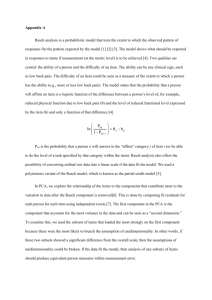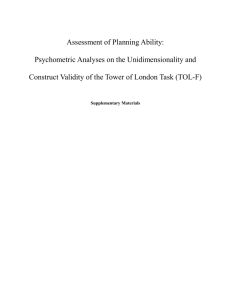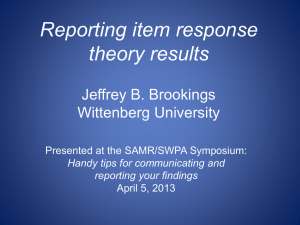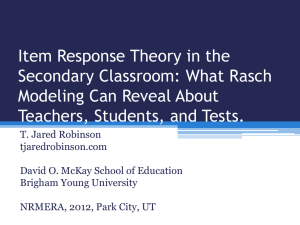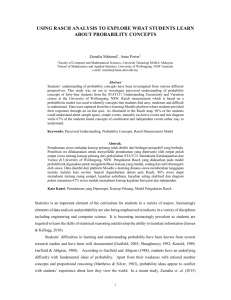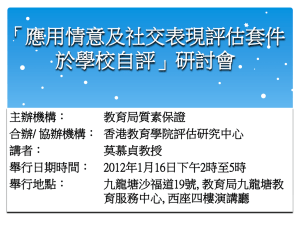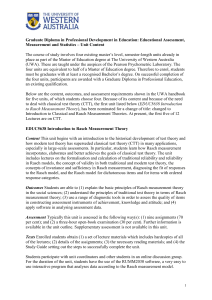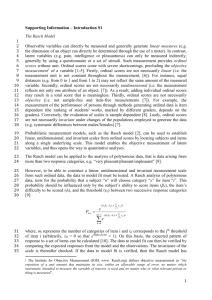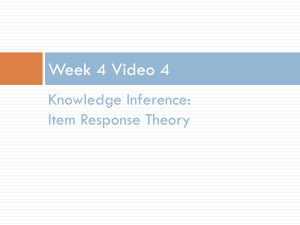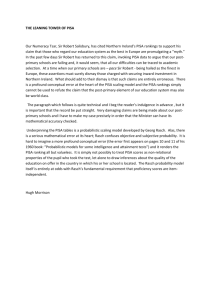MOTIVATION AT WORK: - American Psychological Association
advertisement
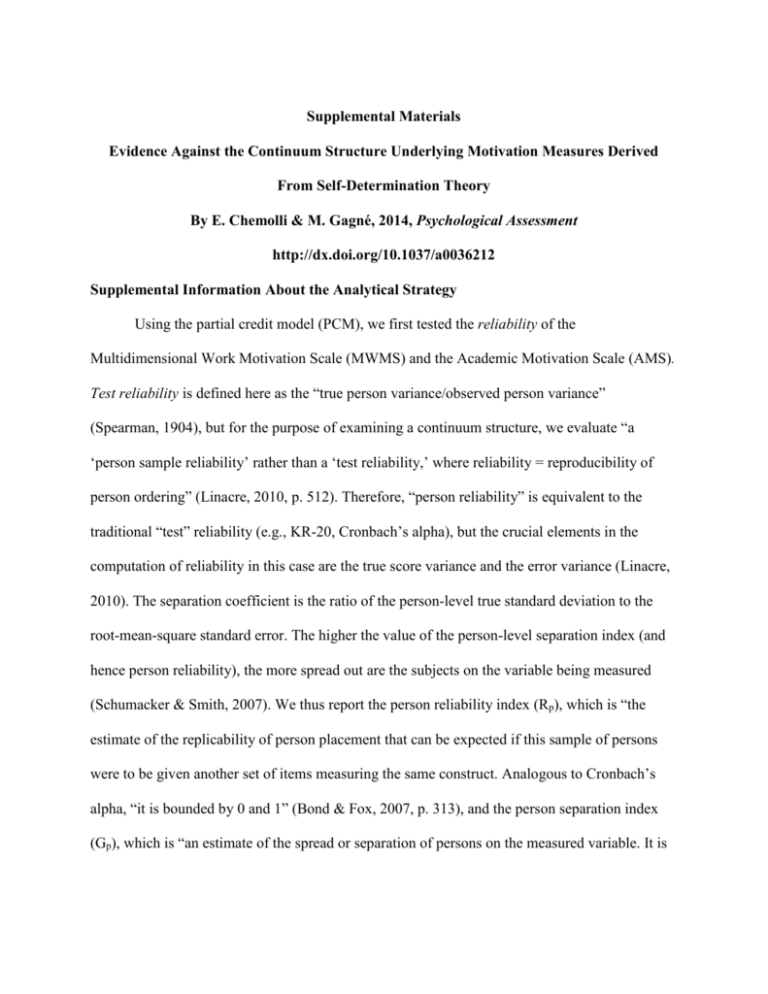
Supplemental Materials Evidence Against the Continuum Structure Underlying Motivation Measures Derived From Self-Determination Theory By E. Chemolli & M. Gagné, 2014, Psychological Assessment http://dx.doi.org/10.1037/a0036212 Supplemental Information About the Analytical Strategy Using the partial credit model (PCM), we first tested the reliability of the Multidimensional Work Motivation Scale (MWMS) and the Academic Motivation Scale (AMS). Test reliability is defined here as the “true person variance/observed person variance” (Spearman, 1904), but for the purpose of examining a continuum structure, we evaluate “a ‘person sample reliability’ rather than a ‘test reliability,’ where reliability = reproducibility of person ordering” (Linacre, 2010, p. 512). Therefore, “person reliability” is equivalent to the traditional “test” reliability (e.g., KR-20, Cronbach’s alpha), but the crucial elements in the computation of reliability in this case are the true score variance and the error variance (Linacre, 2010). The separation coefficient is the ratio of the person-level true standard deviation to the root-mean-square standard error. The higher the value of the person-level separation index (and hence person reliability), the more spread out are the subjects on the variable being measured (Schumacker & Smith, 2007). We thus report the person reliability index (Rp), which is “the estimate of the replicability of person placement that can be expected if this sample of persons were to be given another set of items measuring the same construct. Analogous to Cronbach’s alpha, “it is bounded by 0 and 1” (Bond & Fox, 2007, p. 313), and the person separation index (Gp), which is “an estimate of the spread or separation of persons on the measured variable. It is expressed in standard error units, that is, “the adjusted person standard deviation by the average measurement error” (Bond & Fox, 2007, p. 313). In a second step, we tested for unidimensionality, which, in the Rasch model, is the representation of item “difficulty” and person “motivation” along the same continuum. For our purposes, it is very important to understand the meaning of unidimensionality referred to herein. Unidimensionality is frequently defined as a single latent trait (Smith, 2002). But Bejar (1983, p. 31) noted that: unidimensionality does not imply that performance on items is due to a single psychological process. In fact, a variety of psychological processes are involved in responding to a set of test items. However, as long as they function in unison –that is, performance on each item is affected by the same process and in the same form– unidimensionality will hold. There are various ways to test this assumption, and we chose a principal components analysis of the residuals, as our purpose was not to construct variables, but to explain variance (Linacre, 2010). Wright (1996) postulated that if the data are unidimensional, the components in the residuals, the unexplained part of the data (Linacre, 1998), will simply be noise (Raîche, 2005). This test implies that once the Rasch dimension has been taken into account, there should be no further association between the items other than random association. The absence of any meaningful pattern in the residuals will also be deemed to support the assumption of unidimensionality (Tennant & Conaghan, 2007). Residual fit statistics provide useful information regarding the violation of the unidimensionality principle (Bond & Fox, 2007). Finally, we diagnosed misfitting persons and items using Rasch fit indicators, and the dimensionality using Rasch principal component analysis. Supplemental Results for the MWMS The PCM also provides estimates for the accuracy of the measures, specifically, for the observed response patterns. It is important to understand the scale’s psychometric characteristics, because this reflects how well the scale (which represents our understanding of reality) tests the theory (which represents the conceptual level of our understanding).The fit analysis is based on the computation of the difference between expected and observed scores. We used two fit statistics. The first is the Infit statistic, which indicates “the degree of fit of observations to the Rasch-modeled expectations, weighted to give more value to on-target observations. Infit statistics are more sensitive to irregular inlying patterns” (Bond & Fox, 2007, p. 310). The second is the Outfit statistic, which is the “unweighted estimates of the degree of fit or responses. These unweighted values tend to be influenced by off-target observations” (Bond & Fox, 2007, p. 312). These fit statistics are calculated from the sum of squared residuals, typically have an expected value of 1.0, and fit the model well when they range from 0.5 to 1.5 (Linacre, 2003; Wright & Masters, 1982). Finally, to investigate the unidimensionality of the data, we diagnosed misfitting persons and items using Rasch fit indicators and the dimensionality using Rasch factor analysis. As Bond and Fox (2007, p. 235) highlighted that, the concept of fit must be considered hand-in-hand with that of unidimensionality. The concept of unidimensionality reflects Rasch model’s focus on the process of fundamental measurement, and it is essential that our data fit the model in order to achieve invariant measurement within the model’s unidimensional framework. In addition to results reported in the article, we considered the fit on a continuum of both items and participants. If an item does not produce a value that fits the expected pattern, it is assumed that the item is not measuring the same construct as other items; if a person has a score that does not fit the pattern, it decreases the precision of difficulty parameter estimates (Miceli, Settanni, & Vidotto, 2008). In other words, poor item fit indicates that the item parameters have questionable validity (i.e., they do not accurately represent how examinees respond to test items), while poor person fit indicates that the trait level estimate has questionable validity (i.e., the trait level estimate may be a poor indicator of an examinee’s position on the latent continuum). (Reise, 1990, p. 127) With regard to the MWMS items, our analysis showed a maximum Infit value of 1.26 with no overfitting items (Infit < 0.5), and with a minimum Infit value of 0.79. The Outfit values did not include any misfitting or overfitting items: The highest Outfit value was 1.40, and the lowest was 0.78 (see Table S1). These results indicate that the item parameters have good validity. With regard to participants, both Infit and Outfit values showed misfitting and overfitting. The Infit values ranged from 4.81 to 0.06. Thirty percent of the participants showed overfitting, whereas 10.2% showed slight misfitting (Infit value between 1.50 and 2.00), and 11.9% showed misfitting. Outfit values were also not in the acceptable range, ranging from 6.48 to 0.06 (30% of people showed overfitting, 9.5% slight misfitting, and 12.6% misfitting). This means that for over 1,000 people, their scores do not appear to fit the model, meaning that the trait-level estimate is a poor indicator of an examinee’s position on the latent continuum. Table S1 Item Statistics for the MWMS Item Measure SE INFIT OUTFIT PTBS (mnsq) (mnsq) correlation Ex1 .14 .02 1.00 1.02 .53 Ex2 .28 .02 .96 .98 .56 Ex3 .49 .02 1.11 1.15 .49 Ex4 .24 .02 1.26 1.32 .44 Ex5 .49 .02 1.14 1.17 .47 Ex6 .21 .02 1.23 1.40 .45 Ij1 −.08 .02 .90 .93 .60 Ij2 −.51 .02 .79 .78 .65 Ij3 .02 .02 1.04 1.09 .51 Ij4 −.05 .02 1.13 1.18 .47 Id1 −.27 .02 .94 .95 .57 Id2 −.23 .02 .86 .87 .61 Id3 −.05 .02 .88 .88 .60 In1 −.28 .02 .94 .95 .55 In2 −.16 .02 .95 .96 .55 In3 −.24 .02 .95 .97 .55 M .00 .02 1.01 1.04 SD .28 .00 .13 .16 Note. Ex = external regulation; Ij = introjected regulation; Id = identified regulation; In = intrinsic motivation. Supplemental Analysis for the AMS In addition to results reported in the article, we found, with regard to items, that the Infit values ranged from 1.36 to 0.75 and that there were no overfitting items. The Outfit values detected the presence of only two slightly misfitting items, with Outfit values ranging from 1.62 to 0.74 (see Table S2). These results indicate that the item parameters have a good validity. With regards to participants, both Infit and Outfit values showed misfitting and overfitting. The Infit values ranged from 3.19 to 0.17. In terms of Infit values, 15.5% of people showed overfitting, 7.9% showed slight misfitting (Infit value between 1.50 and 2.00), and 7.5% showed misfitting. Outfit values were not in the acceptable range, from 9.90 to .17 (15.9% of people showed overfitting, 8.9% slight misfitting, and 7.7% misfitting). This means that for over 160 people, their scores do not appear to fit the model. Table S2 Item Statistics for the AMS Item Measure SE INFIT (mnsq) OUTFIT (mnsq) PTBS correlation Ex1 .15 .03 1.36 1.42 .24 Ex2 −.14 .03 .88 .86 .53 Ex3 −.18 .03 .88 .90 .52 Ex4 −.18 .03 .79 .79 .57 Ij1 .55 .03 1.29 1.62 .35 Ij2 .23 .03 .77 .77 .63 Ij3 .73 .03 1.17 1.48 .40 Ij4 .65 .03 1.20 1.52 .39 Id1 −.59 .03 1.13 1.14 .31 Id2 −.68 .04 1.07 1.14 .31 Id3 −.65 .04 1.09 1.13 .30 Id4 −.44 .03 1.25 1.46 .20 In1 .60 .03 1.16 1.30 .42 In2 −.12 .03 1.13 1.24 .31 In3 .18 .03 .79 .79 .60 In4 −.15 .03 .91 .89 .50 In5 −.06 .03 .87 .88 .53 In6 .55 .03 1.11 1.23 .46 In7 −.26 .03 .78 .75 .58 In8 −.16 .03 1.04 1.09 .39 In9 .18 .03 .75 .74 .63 In10 −.09 .03 .82 .80 .56 In11 −.25 .03 1.01 1.03 .41 In12 .12 .03 .76 .77 .62 M .00 .03 1.00 1.07 SD .40 .00 .19 .28 Note. Ex = external regulation; Ij = introjected regulation; Id = identified regulation; In = intrinsic motivation. References Bejar, I. I. (1983). Achievement testing: Recent advances. Beverly Hills, CA: Sage. Bond, T. G., & Fox, C. M. (2007). Applying the Rasch model: Fundamental measurement in the human sciences (2nd ed.). Mahwah, NJ: LEA. Linacre, J. M. (1998). Structure in Rasch residuals: Why principal components analysis (PCA)? Rasch Measurement Transactions, 12, 636. Retrieved from http://www.rasch.org/rmt/rmt122m.htm Linacre, J. M. (2003). A user’s guide to WINSTEPS: Rasch-model computer programs. Chicago, IL: MESA Press. Linacre, J. M. (2010). A user’s guide to Winsteps, Ministep: Rasch-Model Computer Programs. Chicago, IL. Miceli, R., Settanni, M., & Vidotto, G. (2008). Measuring change in training programs: An empirical illustration. Psychology Science Quarterly, 50, 433-447. Raîche, G. (2005). Critical eigenvalue sizes in standardized residual principal components analysis. Rasch Measurement Transactions, 19, 1012. Retrieved from http://www.rasch.org/rmt/rmt191h.htm Reise, S. P. (1990). A comparison of item- and person-fit methods of assessing model-data fit in IRT. Applied Psychological Measurement, 14, 127–137. doi: 10.1177/014662169001400202 Schumacker, R. E., & Smith, E. V. (2007). Reliability: A Rasch perspective. Educational and Psychological Measurement, 67, 394–409. doi:10.1177/0013164406294776 Smith, E. V. (2002). Detecting and evaluating the impact of multidimensionality using item fit statistics and principal component analysis of residuals. Journal of Applied Measurement, 3, 205–231. Spearman, C. (1904). “General intelligence” objectively determined and measured. American Journal of Psychology, 15, 201–293. Tennant, A., & Conaghan, P. G. (2007). The Rasch measurement model in rheumatology: What is it and why use it? When should it be applied, and what should one look for in a Rasch paper? Arthritis & Rheumatism, 57, 1358–1362. doi:10.1002/art.23108 Wright, B. D. (1996). Local dependency, correlations and principal components. Rasch Measurement Transactions, 10, 509–511. Retrieved from http://www.rasch.org/rmt/rmt103b.htm Wright, B. D., & Masters, G. N. (1982). Rating scale analysis: Rasch measurement. Chicago, IL: MESA Press.
